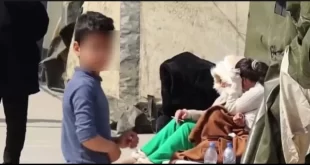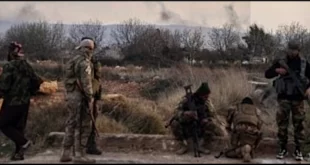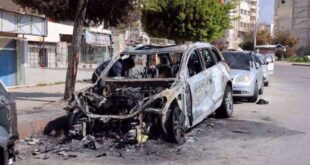Nov 18, 2014, Al Akhbar
Once again, the capital of the Syrian north finds itself the center of a proposal for an agreement among the parties to the conflict, despite the lack of any indications suggesting UN envoy to Syria Staffan de Mistura’s proposal could become a viable agreement and put an end to suffering in the city of Aleppo. Al-Akhbar sheds light on the armed groups present in the city, and the reality of their regional and international links, which will have a fundamental role in the success or failure of the international envoy’s proposals.
The proposal made by the UN envoy to Syria, Staffan de Mistura, to “freeze the fighting in Aleppo,” is not the first proposal seeking to reach such an agreement between the warring parties in the capital of northern Syria. In January, in conjunction with preparations for the Geneva II Conference, there was a similar conversation, albeit it involved different details.
At the time, Syrian Foreign Minister Walid al-Moallem even handed his Russian counterpart Sergei Lavrov a project for security arrangements in Aleppo, before it turned out that regional conditions were not ripe enough for that agreement. Today, amid caution in the Aleppo street over pinning too much hopes on de Mistura’s plan, it seems worthwhile to shed light on the reality of the armed groups in Aleppo and their regional and international links.
Pro-Qatar and pro-US groups:
- The Hazm movement was initially a Muslim Brotherhood-aligned project, before it was realigned to look more “secular.” Hazm rose to the top of the list of rebel groups eligible for US support. Hazm is said to comprise around 1,000 fighters. The group has a strong presence in the countryside, especially in Maarat al-Artiq, and has several bases inside the city. Last month, Hazm handed over some of its position to the Army of Mujahedeen.
- The Nur al-Din Zinki Movement is one of the strongest factions in the Aleppo countryside. As a result, this group controls strategic positions that give it a strong influence in the city. The movement is estimated to have 2,000 fighters. Its strongest formation is Liwaa al-Ansar, which consists of smaller groups such as Amjad al-Khilafa and Kataeb al-Quds.
Initially, the group was aligned with Turkey. Its leader Sheikh Tawfiq Shihab al-Din then shifted his allegiance to Qatar (and the United States behind it) in April, after a visit to Doha. Upon his return, he split from the Army of Mujahedeen and changed his group’s name from Nur al-Din Zinki Brigades to Nur al-Din Zinki Movement, and forged an alliance with Hazm.
- The Army of Mujahedeen was formed earlier this year. The group played a key role in battles against ISIS in Aleppo and the countryside. The group’s leaders are trying to market themselves as moderates who are not under direct US control. They also maintain good relations with the Qataris.The group is estimated to have 3,000 fighters. In addition to its influence in the countryside, it is widely seen as one of the most powerful militant groups in the city, especially in the districts of Salahuddin, Amiriyah, Ramouseh, and al-Rashideen.
Opposition sources on the ground told Al-Akhbar that the leaders of these three groups held meetings with US Secretary of State John Kerry in Turkey, before the coalition began air strikes against ISIS. One of the sources said, “Hazm and Zinki in particular receive direct US guidance, even in the simplest matters, such as telling their fighters not to grow beards.”
Saudi-sponsored groups
Saudi Arabia is in a unique position when it comes to the groups it supports. Both jihadi groups such as Jaysh al-Muhajirin wal Ansar, and other ‘moderate’ groups such as the Syrian Revolutionaries Front, receive Saudi support.
- Jaysh al-Muhajirin wal Ansar, a group comprising approximately 1,000 Chechen fighters, had split up from al-Nusra Front but refused to join ISIS. Al-Muhajirin wal Ansar is led by Salah al-Din al-Shishani. The group is funded, armed, and steered by Saudi Arabia.Al-Muhajirin wal Ansar is one of the most formidable components of the Ansar al-Din Front, which was formed not long ago, and of which Salah al-Din al-Shishani is considered the de facto leader. The group’s most prominent deployment points in Aleppo are Ramouseh, Bellermoun, and al-Rashideen.
- Liwaa Ahrar Suriya is currently led by Mahmoud Afash, after its founder Ahmed Afash ‘retired.’ The group is considered one of the leading criminal groups operating in the name of the revolution. It was founded with unofficial Saudi funding, through ‘pro-revolutionary’ individuals and groups. Its financiers continue to exert strong influence on the group. Liwaa Ahrar Suriya’s influence receded greatly, and now operates mostly out of the neighborhoods of the old city in Aleppo. It also maintains some presence in areas dominated by Jaysh al-Muhajirin wal Ansar. Liwaa Ahrar Suriya took part in many attacks targeting the Aerial Intelligence headquarters.
- The Syrian Revolutionaries Front does not have real presence inside the city of Aleppo, though multiple sources say the group has ‘sleeper cells’ there, and local groups that are secretly allied to it. In the past two days, there have been rumors that the Syrian Revolutionaries had carried out attacks against and seized al-Nusra Front bases in the city, though Al-Akhbar’s sources have denied this claim.
Pro-Turkish groups
The Turks supported most armed groups in northern Syria, but gave Turkmen groups special treatment. According to an opposition source on the ground, “the weapons supplied to these groups were from the beginning advanced weapons that are superior to other groups’ arms.” These groups are estimated to have 4,000 fighters in Aleppo and the countryside at present, though previously, they had more than 7,000 fighters.
The most prominent of these groups are the Liwaa Ahfad al-Fatihin, Liwaa al-Salajiqa, Liwaa al-Sultan Murad, and Liwaa al-Sultan Abdul-Hamid. They are deployed in the districts of Sheikh Fares, Bustan al-Basha, al-Halak, Baaydeen, al-Sakhour, and al-Haidarieh.
Groups with overlapping loyalties
- The Islamic Ahrar al-Sham movement was until recently considered one of the groups affiliated to Saudi Arabia. But the assassination of its leaders confused matters in its ranks. A wing affiliated to the Turks has since risen, competing with the pro-Saudi wing, which is still present but has less momentum. Not many believe Ahrar al-Sham is strongly present in Aleppo, though it controls a number of posts in most neighborhoods, benefiting from its alliance with the Islamic Front factions, particularly Liwaa al-Tawhid.
- Liwaa al-Tawhid was at the top of the groups closely linked to Turkey and the Muslim Brotherhood. But the group lost its previously strong momentum as a result of several factors, most notably the assassination of its military commander Abdel-Qader Saleh aka Haji Mareh. At present, Liwaa al-Tawhid is no longer among the powerful actors, though it continues to maintain direct presence in some neighborhoods and through joint formations in other districts, such as the Dabek Group, which is active in the old city of Aleppo.
- Al-Nusra Front is one of the most prominent groups that most powers have tried to coax – including the Turks, Saudis, Qataris, and even the Americans. These powers took turns in supporting and manipulating al-Nusra Front, some directly, and others through religious or jihadi mediators. Al-Nusra Front is allegiant to the parent organization of al-Qaeda. Al-Nusra is deployed in many of Aleppo’s districts, especially: al-Sakhour, al-Haidarieh, and the old city. Al-Nusra Front also controls some water and electricity services.
Local groups
There are groups that have local components, with varying strength and numbers of fighters, in Aleppo. Most of them are linked to larger groups, which have regional affiliations.
Among the local groups are the Istaqim Kama Umirta Brigades, the Abu Amara Special Operations group, and Liwaa Shuhadaa Badr, which controls the vast area of Bani Zaid, and is another criminal organization operating in the name of the revolution. Sources on the ground claim the Liwaa Shuhadaa Badr’s leader Khaled Hayyani is linked to Syrian intelligence.
The remainder of the groups, which are affiliated to the Free Syrian Army, now maintain a merely symbolic presence.
 Syria Support Movement solidarity with the Syrian people
Syria Support Movement solidarity with the Syrian people




